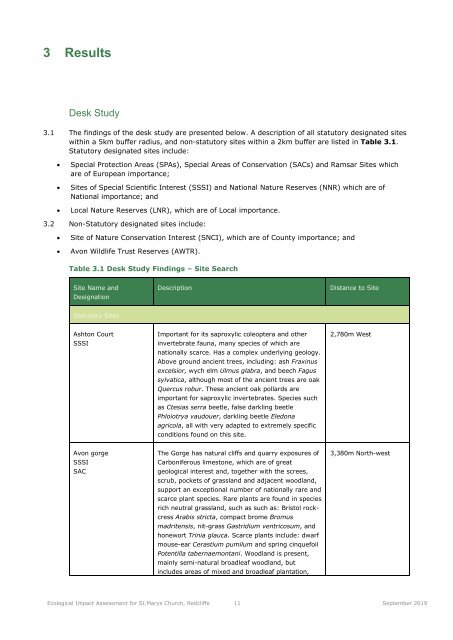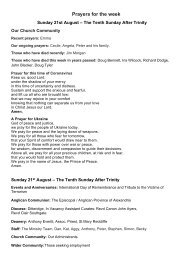St Mary Redcliffe Ecological Impact Assessment
You also want an ePaper? Increase the reach of your titles
YUMPU automatically turns print PDFs into web optimized ePapers that Google loves.
3 Results<br />
Desk <strong>St</strong>udy<br />
3.1 The findings of the desk study are presented below. A description of all statutory designated sites<br />
within a 5km buffer radius, and non-statutory sites within a 2km buffer are listed in Table 3.1.<br />
<strong>St</strong>atutory designated sites include:<br />
• Special Protection Areas (SPAs), Special Areas of Conservation (SACs) and Ramsar Sites which<br />
are of European importance;<br />
• Sites of Special Scientific Interest (SSSI) and National Nature Reserves (NNR) which are of<br />
National importance; and<br />
• Local Nature Reserves (LNR), which are of Local importance.<br />
3.2 Non-<strong>St</strong>atutory designated sites include:<br />
• Site of Nature Conservation Interest (SNCI), which are of County importance; and<br />
• Avon Wildlife Trust Reserves (AWTR).<br />
Table 3.1 Desk <strong>St</strong>udy Findings – Site Search<br />
Site Name and<br />
Designation<br />
Description<br />
Distance to Site<br />
<strong>St</strong>atutory Sites<br />
Ashton Court<br />
SSSI<br />
Important for its saproxylic coleoptera and other<br />
invertebrate fauna, many species of which are<br />
nationally scarce. Has a complex underlying geology.<br />
Above ground ancient trees, including: ash Fraxinus<br />
excelsior, wych elm Ulmus glabra, and beech Fagus<br />
sylvatica, although most of the ancient trees are oak<br />
Quercus robur. These ancient oak pollards are<br />
important for saproxylic invertebrates. Species such<br />
as Ctesias serra beetle, false darkling beetle<br />
Phloiotrya vaudouer, darkling beetle Eledona<br />
agricola, all with very adapted to extremely specific<br />
conditions found on this site.<br />
2,780m West<br />
Avon gorge<br />
SSSI<br />
SAC<br />
The Gorge has natural cliffs and quarry exposures of<br />
Carboniferous limestone, which are of great<br />
geological interest and, together with the screes,<br />
scrub, pockets of grassland and adjacent woodland,<br />
support an exceptional number of nationally rare and<br />
scarce plant species. Rare plants are found in species<br />
rich neutral grassland, such as such as: Bristol rockcress<br />
Arabis stricta, compact brome Bromus<br />
madritensis, nit-grass Gastridium ventricosum, and<br />
honewort Trinia glauca. Scarce plants include: dwarf<br />
mouse-ear Cerastium pumilum and spring cinquefoil<br />
Potentilla tabernaemontani. Woodland is present,<br />
mainly semi-natural broadleaf woodland, but<br />
includes areas of mixed and broadleaf plantation,<br />
3,380m North-west<br />
<strong>Ecological</strong> <strong>Impact</strong> <strong>Assessment</strong> for <strong>St</strong>.<strong>Mary</strong>s Church, <strong>Redcliffe</strong> 11 September 2019


















